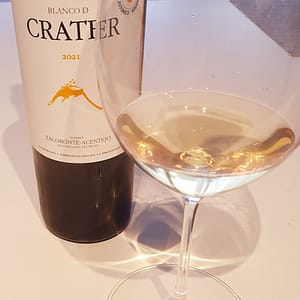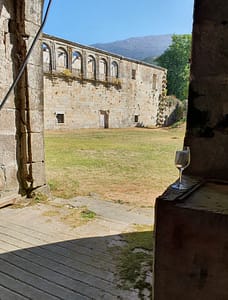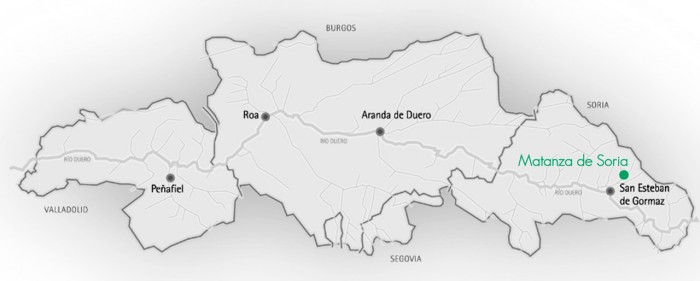The Real Wine fair is of course an opportunity to see what’s going on in the wine category that I love the most, exactly the kind of wine that’s highlighted here. And it’s a welcome chance to say hello to some old friends, and meet new people, all of them with interesting projects. Spain is (together with the other country on the peninsula) the country where I travel the most, and here are some highlights. Because I taste these wines once in a while I didn’t visit all the tables, which I regret, but you know, too little time…

Pedro Olivares
I had not really started when I spotted Pedro Olivares, and at the same time Alfredo Maestro tappet me on the shoulder. Pedro’s wines I just tasted very superficially, as I had recently visited him in Murcia. (Read about my visit here.) I took the opportunity to re-taste the Bobastrell 2015. We can call it a “terroir wine”, but from two terroirs: This is a wine with primarily monastrell (from Bullas, Murcia) in the aroma, and bobal (from Utiel-Requena, València) in the mouth. The enTreDicho 2016, jaén negro version, is a clay aged wine from that maybe unlikely place of Jaén, Andalucía. Pure fruit, flowers, juicy and lovely with some structure. I also took the chance to re-taste the Alto Viognier 2016, a 2 month skin-contact wine with grapes from 1.600 meters above sea level, and the SaSa 2016 from 10 meters, a moscatel and malvasía with the moscatel shining well through.

Alfredo Maestro
Alfredo Maestro Tejero is operating both in his native Peñafiel, in Sierra de Gredos and in other parts of Castilla too. I know him as a man full of tireless energy, and very un-selfish. I wrote him before a trip to Gredos a couple of years ago, and as leader of the Garnachas de Gredos group (now also comprising albillos), he suggested that he organized the whole trip for me. And in the end we drove around together visiting ten producers, including his own vineyard in the coldest part, Navarredondilla (Ávila province). He recuperates old vineyards, manages them organically (with some biodynamic techniques) with little or no additives.
Peñafiel is in the heart of Ribera del Duero, but Alfredo choses to stay outside the DO, to be able to use grapes from neighbouring areas such as Valtiendas to the south the Duratón river. So most of his wines are now under the label Vino de la Tierra Castilla y León. Here are some very brief comments.
The white Lovamor 2016 is a high altitude albillo real (770-1.000m) from more 100-120 year old vines in Olmos de Peñafiel with one week skin-contact, and due to the cold Castilian winter it didn’t undergo malolactic fermentation. The result is an orange-light brownish colour, flowery with orange peel aromas, full and fresh on the palate, slightly pétillant too. From the same place comes Amanda Rosado Lágrima 2016, a light red rosé from the garnacha tintorera grape with pure raspberry fruit, just delicious drinking. As the term “lágrima” suggests the pressing was very light.
Almate 2016 is a tempranillo (here called tinto fino) of various ages, some bush vines (‘en vaso’), some of the younger trained in ‘espaldera’, some found in Peñafiel, and some in Valtiendas, just outside the Ribera del Duero border. Here are lots of vines grown on river stones and clay-calcareous soils. The must was fermented in steel, 80% whole bunches with wild yeasts, then kept in neutral French oak for 2-4 months. This is one of my favourite wines from the region, with its fresh top-fruit of cherries and violets, and a wild, rougher layer underneath, together with a really refreshing acidity. Over the border to the Burgos province, in clay-calcareous soils at 960 meters, Castrillo de Duero is one of the few wines with some oak ageing worth mentioning. Having said that, it’s not more than 12 months in rather neutral French oak, and it bears it without trouble. The 2015 vintage is dark, it has a lovely fruit, it’s a bit balsamic, but not at all oaky.
Amongst all the amusing labels I chose this one:

El Rey del Glam 2016 is sourced from grapes both in Peñafiel (sandy, clay-calcareous soil) and Navarredondilla (granite). It’s a garnacha, obviously high-altitude, and the vines varies between 30 and 100 years old. This is maybe Afredo’s most quaffable wine; beware, it’s so luscouis, delicious that it doesn’t take long before you are sliding over the floor like the glamour king on the label. It’s made from uncrushed bunches that undergo carbonic maceration, fermented with wild yeasts and with no SO2 added. It’s light in colour, with plenty of lovely raspberry fruit, with a dry finish. This takes us over into the Gredos mountain range. El Marciano 2016 is raised, not on Mars, but 1.150 meters above sea level, where the climate is extreme continental. The vines are 70 years old, and the soil is granitic. The late-ripening garnacha is not harvested untill mid-October. This vintage is particularly appealing, with a clear-cut fruit, and a wonderful acidity that’s not easy to obtain with garnacha. Alfredo also brought a few wines outside the program just to show there are interesting projects around the corner. Among these were Rosado Clásico de Valladolid 2015, a rosé from Cigales, the once prominent rosé area just outside Valladolid city. It’s a single vineyard, predominantly tempranillo, raised partly in chestnut. It was peach-coloured with pure raspberry and citric fruit, and a nice concentration.

Dani Landi and Fernando García
Daniel Landi-Jiménez and Fernando García were there, representing both the Comando G project (Madrid province), but Daniel had also brought wines from his own bodega in Méntrida, Toledo. I have commented on these wines several times before (like here in Bilbao, and here at another fair), so I will present them only briefly. These are very fine wines with a refreshing acidity, an almost ethereal elegance, not much macerated and the aromas often show flowery notes. Two old favourites are La Bruja de Rozas 2015 and Las Rozas 1er Cru, now in the 2015 vintage too. The Bruja comes from several plots in and around Las Rozas de Puerto Real, and has a lively fruit, and an acidity that forms a fine structure together with a touch of tannin. The 1er Cru har only a slighly firmer tannin, a touch of smokiness and more concentration. Mataborricos Tinto 2014 was new to me, naturally made in four amphoras, but in the same line as the others. Las Umbrías 2014, a single vineyard wine from granite soils: A tight grip on this one (young tannins), raspberry and cherry fruit and some chalky minerality.
Over in the Toledo province Dani had equally light-coloured, high-expressive wines. He tells that he is always looking for vineyards that is high in the landscape, north-northeast facing, as he wants maximum freshness. Las Uvas de la Ira 2015 and Cantos del Diablo 2014, both from San Vicente, showed this. Las Iruelas 2014 too, from 1.000m elevation in El Tiemblo. El Reventón 2014 from Cebreros (that probably will be the name of the new DO) was the most reductive wine, but with air it reveals lavender and thyme aromas.
Note: I was really sad to hear the other day, that the Gredos area had been affected by severe hailstorms (7th July), and that some of the vineyards you have read about here were among the most severely hit. I really do hope that they will recover the best way possible.

Rafa Bernabé, sr. & jr. of Bernabé Navarro
Rafa Bernabé (father) is long considered the Spanish expert on clay vessels for wine storage (in Spanish called ‘tinajas’), and I have reported on his wines several times, such as the Tinajas de la Mata, from the national park in Torrevieja. The wine, with 2014 on show here, will go out of production, he tells.
Most wines are made “O meters above sea level”, as Rafa sr. puts it. All wines are made with natural yeasts, none are clarified nor filtered, and all have less than 15 grams sulphur. They presented other wines aged in clay such as the Benimaquía Tinajas 2015, from moscatel and merseguera; light orange colour, aromatic with flowery compounds, it had more skin-contact than the “Tinajas” mentioned above, but still lighter in colour (as the other one has a small amount of black grapes). Musikanto 2015 is a direct-press wine (no skin-contact) garnacha from a higher altitude at 700 meters; light red, and very luscious in the mouth.
They had also a pét nat called Acequión 2015, a “sea moscatel”; deep yellow, with aromas of orange peel and yellow apples, slightly bubbly, and a “mountain monastrell 85% and garnacha”, Tipzzy 2015; light red, easy-to-drink. A dessert wine rounded it off, the Parque Natural 2013, that showed mature apples and dried fruit, some raisins, but it was not overtly sweet either.
Saó del Coster is a new find. I had heard about the winery from Gratallops, Priorat, and was lucky to be able to be pick up their basic “S” (2014) in my local shop, a wine with all the charms of a young, fruity red priorat. They want to keep the alcohol up at 15, to emphasize the local style, full and warm. Here the vintage has changed to 2015, and it’s still a lovely, pure garnacha-dominated wine (carinyena 35%), some spices and minerals, and with a good acidity for freshness.
They work biodynamically with indigenious varieties, with a low-intervention philosophy. A 100% garnatxa (as it’s spelled in Catalan) is Pim Pam Poom 2016. This has been made with 50% whole clusters, with the aim of bringing out minimum colour, maximum flowery, fresh fruit. Pure delight! They also brought two wines from old carinyena. The Planassos 2014 was good, warm and potent, but also with a velvety layer. For me La Pujada 2014 from 90 year old plants was a winner, very elegant with relatively lighter colour, fresh fruits, juicy in the mouth, and a subtle, almost cool fruit all the way.

Xavier Barrachina and Michelle Negrón of Saó del Coster
Rioja was represented by three producers from the right bank of Ebro; Honorio Rubio (Cordovín, once famous for claretes), Hacienda Grimón (further east, in the Jubera valley, Rioja Baja) and Viña Ilusión (Herce, near Arnedo in the Rioja Baja).
Honorio Rubio is noted for their whites, and it was especially interesting to taste the Edición Limitada-range with three very different wines. The skin-contact Viura Macerado 2014 was orange in colour, aromas of apricot and lemon, and some more herbal notes, quite light in the mouth, and with a refreshing acidity from the high altitude viura grapes. The Viura Sobre Lías Crianza 2014, aged 6 months in oak and concrete, it’s both traditional lemon and vanilla, and comes with a modern fruitiness too. Añadas is a solera wine made up from ten vintages, thus mixing the sherry and barrel-aged rioja traditions. It’s light golden, with lemon, pear and some buttery notes, both concentrated and fresh. Before I moved on I also tasted two more whites in a hurry, and the Alonso & Pedrajo, Suañe 2014, a raspberry scented red with some sweet notes.
The Oliván Family at Hacienda Grimón uses no chemical fertilisers, but sheep manure like in the old days. No herbicides are used, and the oak is all of second and third year. A couple of favourites were Finca la Oración 2015, a fruity, un-oaked wine full of blackberry aromas and freshness, and Desvelo Garnacha 2015, with second fermentation in oak (7 months); very flowery, red berries, and good weight in the mouth.
Martín Alonso of Viña Ilusión I have met several times, so I tasted his main wine very quickly. His Tinto 2015 is really nice and clean, fruity and elegant, with cherry and blackberry fruit, and good acidity.
Beginning to count down for lunch I did a brief tasting of a winery that I have known for some time. Who said they couldn’t make wine in Asturias? Nicolás Marcos can, and he does so in Cangas, that emerges as the area to consider in the region. At this occation I only tasted four wines. Pesico Blanco 2014 from the albarín variety, not destemmed, aged in chestnut vats of 2.000 liters, bottled without SO2 was glyceric, smooth but still with a young fruit. La Fanfarría Tinto 2015, 50% each of mencía and red albarín, was quite dark with red fruits, herbs and young tannin. Retortoiro Tinto 2014 showed some evolution in the colour, with aromas of cherries, and a structure for further ageing. Cadario 2012 had still more evolved colour, but the evolution has been nice, the tannins are still evident, and the primary fruits are still holding first place. I believe these wines can easily keep for ten years.

Then running for lunch, I passed Adega Guímaro‘s table. Guímaro can be found in the cool Amandi sub-region of Ribeira Sacra, Galicia interior. I know Pedro Rodríguez and his wines well after a visit and several tastings. So here I almost only passed by the table, where his collegue Raúl Suárez was present. I did a quick tasting of the Guímaro 2016 white from 70% godello, a light, flowery, citric wine, the Finca Capeliños 2015 (50% whole cluster, long maturation in foudres) with its dark mencía fruit, mineral and with young tannins, the Finca Pambeiras 2015 (75 year old vines, 100% whole cluster), a very floral, red fruit dominated, very pure wine, before I brought his wonderful young mencía with its vibrant cherry fruit, the Tinto Jóven 2016, out into the lunch area.









































